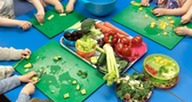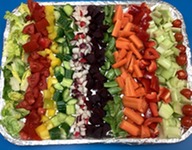|
 Bright Start Blog
|
|
Nurturing children’s healthy eating habits |
|
|
Eight minute read
- How can we prevent fussy eating?
- What role do exposure and familiarity play in helping children to accept new foods?
- What more can we do to help children eat a balanced diet?
|
|
Georgina Trevor, Director and Michelle Moore, Manager at Little Angels Day Nursery and Pre-Prep School share the development of a positive focus on food and nutrition within their early years setting. |
|
|
The relationship between eating a healthy diet and positive health outcomes is well known; nurturing positive eating habits among children has the potential to improve their long term health. The challenge in our nursery (as it is for many parents and settings) is an increased fussiness around food. It wasn’t just a nursery phenomenon; parents were communicating they were struggling to get their children to eat a variety of fruit and vegetables at home too. We decided to look at what steps we could take to tackle the problem.

We started by reflecting on the aspects of our practice which already supported healthy eating habits: Our curriculum is based on learning through play and exploration. We have high quality continuous provision which includes varied and healthy food choices in the play kitchen. During open ended play and focused activities, we take into account the broad range of children’s influences and preferences both in and out of nursery. While engaging with children in role play, practitioners use dialogue and sustained shared thinking that scaffold children’s knowledge about the importance of a balanced and healthy diet, and encourage them to think about the choices they make.
Our menu is designed to ensure healthy, seasonal and balanced meals are offered. One of the aims at mealtimes is to model and promote good relationships with food through exposure to new ingredients and flavours. Children are encouraged to participate in setting up at lunch and serve themselves and their peers. We involve parents by posting meals on our Instagram account and encouraging them to speak with their children about what they ate when they collect at the end of the day. We also invite practitioners in nursery to eat meals with the children, modelling healthy eating habits as well as table manners, how to hold and use utensils and cutlery and encourage discussion about food choices, preferences, different tastes and textures, colours and ingredients.
This had been positive for many of our children but it wasn’t addressing some of the more complex issues we’d been noticing, and some children seemed unengaged and lacking in enthusiasm about food. For some, eating a balanced diet was become a bit of a battle. We knew we needed to do more.
|

Research tells us that children have their own opinions about food choices and, given the choice, often want to participate in decision making about factors which affect them. We decided we wanted to give children more opportunities to become involved in decisions about food in the hope it might encourage them to try something new or extend the food they’re prepared to eat. We thought it was best to do this by adding in new ingredients incrementally, at a pace they were comfortable with.
We involved children in every step of the process; from going to the greengrocers to pick fresh fruit and vegetables, to washing the produce, peeling, cutting and preparing ingredients. We noticed that many children did not know what the whole fruit or vegetable looked like, they only recognised it cut up on their plate. Many were also unaware that there were varieties of different produce, such as different types of tomatoes or colours of pepper.
Children were encouraged to make decisions about what sweet and savoury food they wanted to make for lunch, tea and snacks, both as a group and individually when it came to making their own portion. Practitioners discussed with children how to make food taste sweeter using natural ingredients, for example, explaining we could use ripe bananas instead of sugar. We started using new equipment, such as pastry cutters, as well as using existing equipment in new ways, such as plastic cups to cut vol-au-vent circles. The children also became much more adept at using knives (under adult supervision!) and were able to try new tools with the help of an adult, such as peelers, a hot plate, mashers and a blender.
|

Practitioners observed how children were less likely to eat certain fruit and vegetables depending on their ‘state’; raw spinach on its own was universally disliked but spinach in a fruit and vegetable smoothie was happily eaten. Some vegetables when baked became sweeter, such as butternut squash and sweet potato, and children were far more likely to eat this as a snack on savoury pastry, than when these ingredients were included on a plate as ‘mash’ at lunch time. Some items that resembled food the children liked became popular despite the different flavour, for example savoury ‘crackers’ made from dough filled with chopped vegetables.
The way in which food was presented also impacted on its popularity. Small pieces of regularly eaten vegetables, such as carrot, placed in a snack bowl sometimes went untouched. Whereas when they were presented on a platter and children could pick both what they wanted, and how much of it to eat, they voluntarily tried many more unusual vegetables, such as radish, lettuce and beetroot.
As our focus on food progressed, children started to make their own observations and showed an interest in where food came from. Discussions arose about how and where certain fruits and vegetables grow and practitioners researched with the children on the iPads different seasonal plants, trees, vegetables and herbs. Some children with gardens at home observed fruit growing on bushes and trees which led to practitioners asking if the children would like to grow their own fruit and vegetables. They planted strawberry plants which started to bear fruit within a few weeks. An avocado stone was also grown over a bottle (although never actually produced fruit!) The children were able to try the strawberries once they’d ripened, and enjoyed harvesting other easy to grow plants and herbs, such as cress. We also observed other plants we grew but decided not to harvest, such as cabbage plants.
|

We noticed that through these interventions, children across the whole nursery were eating a wider variety of food. This was initially reflected just in the food children made themselves but soon extended to more confidence with food they hadn’t made. Our kitchen staff reported less food coming back untouched after mealtimes.
The mood at mealtimes improved as trying new food became less of a struggle, and children’s relationship with healthy food choices seemed to improve. Children were excited to share their knowledge of different fruit and vegetables and how to prepare them with each other and adults. Some parents also reported their children seemed “less fussy” at home. Children now understood more of the processes around food, such as buying, preparing and cooking food and took notice of how the cooking process at nursery mirrored what their parents did at home.
Children that previously didn’t engage in messy or sensory play chose to participate in cooking, perhaps because it was more accessible and they felt more comfortable with its familiarity, but also because it was consistently being offered as an activity in the rooms, so they had more exposure to it.
Adults also shifted their approach with the children, and we made a move away from ‘hiding’ healthy ingredients in food in the hope that children would eat them, towards consulting with children on what we could add to a mixture to make it taste better.
|
Taking part in the Silver Healthy Early Years London Award helped us to reflect on the importance of these approaches and we have incorporated many of these strategies into our curriculum and planned activities. Developing our practice in this area has provided countless learning opportunities across the curriculum; learning colours by observing the food we buy and prepare, using new language when cooking, developing fine motor skills when handling tools and chopping, a whole host of mathematical concepts and language when cooking and measuring, pouring and serving, looking at how plants produce fruit and vegetables grow, understanding climates and discovering countries they come from. It has impacted every area of practice and most importantly, it’s been lots of fun!
|
|
About the authors

Georgina has a Foundation Diploma and BA (Hons) in Fine Art and a Masters in Early Years Education from UCL’s Institute of Education. She is also a Trustee of Home-Start Camden and Islington, a charity supporting parents of children under five.
Georgina has published work in the Early Education Journal (with Amanda Ince, 2020), co-written a chapter about curriculum in Transforming Early Childhood in England (with Amanda Ince and Lyn Ang, Cameron & Moss Eds. UCL Press 2020), has spoken at the Early Education Autumn Conference 2020, been a guest speaker focusing on Leadership in Education at the IOE on the Early Years MA course and was invited to be on the Nursery World Roundtable Discussion centred on the updated 2021 EYFS.
Georgina has a continued interest in creative learning approaches with young children, and most importantly has an 8 year old daughter and a 2 year old son.
|

Michelle joined Little Angels 21 years ago as Bank Staff and worked her way up to Pre-School Room Leader before becoming Manager in 2017.
She has a BA (Hons) in New Media Journalism with Media Studies. She fell in love with Early Years and went on to study the Early Years Professional Status in 2011. She has a passion for SEND and recently undertook the Level 3 qualification.
Michelle believes in the importance of using cultural capital to help contextualise children’s understanding and sense of belonging within their community and the wider world. She loves to create amazing opportunities for the children, such as writing to and receiving letters from the Queen and David Attenborough, learning about orangutans in Borneo and delivering Christmas gift baskets to the local residents at the Highbury New Park nursing home.
|
|
|
|
|
|